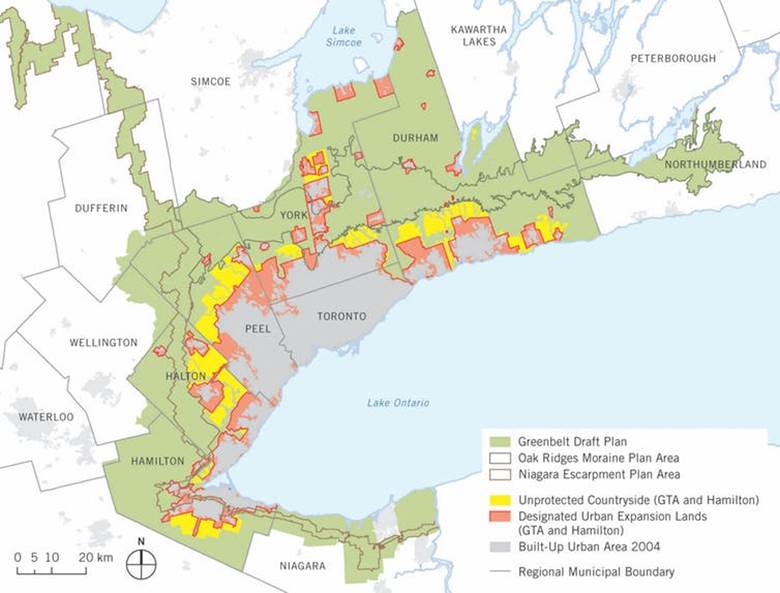
Boomburbs: The Rapid Rise of Toronto's Northern Suburbs
Citylab.com
April 5, 2018
Lorenzo De Vidovich
Not so long ago, the Vaughan and Markham communities were rural areas. Now, their tremendous growth is making them part of the Torontonian “edgeless city.”
The northern suburbs of Toronto are in a period of great transformation. Infrastructure development and new private investments are contributing to the growth of the communities of Vaughan and Markham, two urban cores of York Region to the north of Canada’s biggest city.
These towns are in the middle of a suburban growth that is changing their environment toward a more urban and less rural landscape.
While Vaughan is building a Metropolitan Centre also thanks to the opening of a new Toronto Transit Commission subway station, Markham has turned into a new venue for both private and public investment in the almost never-ending urban development of the Greater Toronto Area.
They’re both what are known as boomburbs—suburban communities in the midst of tremendous growth that were rural areas not so long ago, and aren’t the core cities in their metropolitan areas.
Vaughan and Markham are no longer merely suburbs of Toronto, but are becoming part of the Torontonian “edgeless city” due to the constant urban expansion.
A “growth plane” for the Greater Golden Horseshoe area, comprising the portion of southern Ontario that envelops the western end of Lake Ontario, was drawn up in 2017.
Here, Vaughan and Markham stand at the boundary of what’s known as the Greenbelt area, as shown by a map created by Neptis Foundation, an independent foundation based in Toronto that conducts research and spatial analyses of Canada’s urban regions.
At the same time, Vaughan and Markham are the main engines of the population increase in York Region, which, according to forecasts by Hemson Consulting (a policy and planning analysis company), is expected to grow from the current 1.1 million to 1.5 million by 2031.
In more detail, Neptis Foundation shows how the red line of designated urban expansion land sharply crosses both Vaughan and Markham, as the map below illustrates:

The “growth-machine theory” may be useful to understand the expansion of Vaughan and Markham. In their classic Urban Fortune (1987), Harvey Molotch and John Logan stated that the political and economic essence of any given locality is growth and a common interest in local initiatives of social and economic reforms, at least in the American context.
Given that Vaughan and Markham represent two satellite cities of Toronto, I argue that their current expansion represents a manifestation of the growth machine theory as suburbs are transformed into cityscapes where pro-growth planning and public-private investments play a fundamental role.
The Vaughan Metropolitan Centre
In November 2015, the City of Vaughan approved a Community Improvement Plan (CIP) to encourage the development of the Vaughan Metropolitan Centre.
Two years later, the opening of the TTC Line 1 subway extension represents the first step towards the revitalized Vaughan downtown, as well as a new gateway to downtown Toronto. Vaughan Metropolitan Centre, where the subway station is located, will be a new inter-modal public transit system, able to connect the overlapped transport networks of Toronto, the GTA and York Region.
But mostly, it will be the venue of new prestige offices (KPMG is going to have new headquarters there), hotels and retail opportunities, as this video by the City of Vaughan illustrates:
It’s a modern town within the town, located at the southwestern edge of the city. The forecast for this massive project is illustrated in the seductive video above that imagines a dreamy future for Vaughan, the fastest-growing municipality in all of Canada between 1996 and 2006, achieving a population growth rate of 80.2 per cent, according to Statistics Canada.
This growth looks unstoppable as the construction of the Metropolitan Centre will automatically attract private investment and, basically, more people and more money.
Municipal forecasts predict that by 2031, the Metropolitan Centre alone will be home to 11,500 employees and 25,000 residents.
But what will be the consequences of this new enclave of Vaughan? Will the city experience gaps between social classes due to the growth mismatch between this brand new area and some of its outskirts, including the Italian ethno-burb of Woodbridge? Will the cost of living increase in the entire community of Vaughan?
Some of these questions are also key issues in Markham’s development.
‘Community-building’ in Markham
My Facebook timeline, according to both my interests and “likes,” is constantly displaying a Toronto Star ad. When I decided to click it, I was a little surprised: The link sent me to the interactive page Creating a Community, a fancy website sponsored by BILD (the Building Industry and Land Development Association) that provides detailed information about the development of Markham, framed under the keyword “community.”
Markham’s population grew from 208,615 inhabitants in 2001 to 328,966 in 2016, and it’s now statistically the most diverse community in Canada, according to urban planning experts Roger Keil and Jean-Paul Addie. Markham was a rural area until 25 years ago, and has rapidly morphed into a new city.
